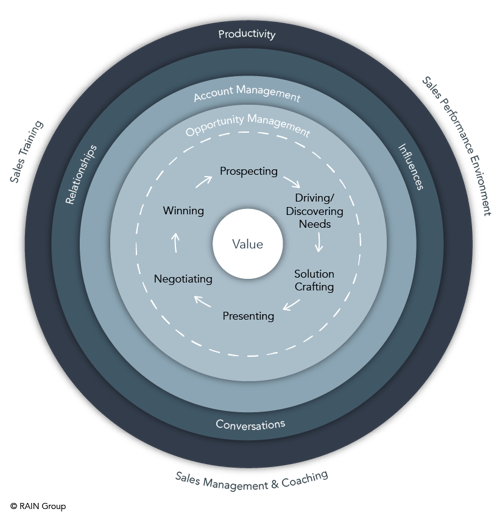Selling is about the whole experience from the first conversation to signing on the dotted line. One wrong move or poor interaction can drive buyers away.
The best sellers strive to deliver value in each interaction, leaving the buyer wanting more and turning to them for advice. What’s more, the best sellers tend to have strong skills across the sale cycle.
Based on our research on where Top-Performing Sellers excel and current challenges and priorities in sales, we’ve identified 24 areas you can focus on to get results.
Download 50 resources to put these tips into practice. >>
24 Sales Tips
17 Areas for Individual Sellers to Focus On
- Value: Understand and Communicate It
- Prospecting: Build Your Referral Network
- Driving and Discovering Need: Lead Thorough Needs Discoveries
- Solution Crafting: Collaborate with Buyers
- Presenting: Deliver Impactful Presentations
- Negotiating: Lead Negotiations
- Winning: Gain Commitment
- Opportunity Management: Align to the Buying Process
- Account Management: Proactively Grow Key Accounts
- Influence: Educate Buyers on New Ideas
- Relationships: Be a Resource for Buyers
- Relationships: Develop Rapport
- Conversations: Tell a Convincing Story
- Conversations: Stand Out in 3 Ways
- Productivity: Establish Your GIA
- Leverage AI: Find a Starting Point
- Learn to Sell to Executive-Level Buyers: Adjust Your Communication Approach
7 Areas for Sales Leaders to Focus On
- Sales Performance Environment: Identify Factors Affecting Performance
- Sales Performance Environment: Measure Your Results
- Sales Management and Coaching: Establish a Rhythm of Sales Coaching
- Sales Management and Coaching: Understand the Power of Motivation
- Sales Training: Drive Change
- Sales Training: Make Training Effective
- Assess Your Sellers: Identify Key Skill Gaps
Research-Validated Sales Competency Model
The number of skills required to succeed in sales may seem intimidating, but you can identify areas of improvement and refine your processes over time. In fact, all the skills are captured in the Top-Performing Seller model—RAIN Group's research-validated sales competency model.
In this article, we cover areas for individual seller improvement relating to the colored areas of the model, and then we tackle the organizational factors on the outside of the model.

17 Areas for Individual Sellers to Focus On
1. Value: Understand and Communicate It
Value is central to sales, but many sellers struggle to communicate value to their buyers. While only 22% of sellers say they find communicating value to be very challenging, a staggering 64% of buyers say sellers aren’t effective at doing so. This tells us that sellers often overestimate their ability to make value clear for the buyer.
If you’re communicating value well, buyers will:
- Want and need what you’re selling
- See how you stand out from available options
- Believe you can deliver on your promises
If you’ve made all three of these things clear, great! If you’re falling short on one or more, it could hurt your chance to win a sale. Every seller’s value will look different, but understanding your value proposition will help you communicate yours.
2. Prospecting: Build Your Referral Network
Among other prospecting tactics, referrals stand out as one of the most effective ways to bring in new buyers.
Put processes in place to make it as easy as possible for your buyers to refer you. Many sellers don’t have a referral strategy or plan, putting them at a disadvantage compared to sellers who are able to ask for, incentivize, and capitalize on referrals. In fact, Top-Performing Sellers are 64% more likely to receive referrals.
When creating a referral program, build ways for buyers to give referrals as seamlessly as possible. Offer incentives where you can, understand when buyers are willing to provide referrals, and engage with them after the initial sales process. Finally, follow the golden rule: givers gain. The more referrals you give, the more you will receive.
3. Driving and Discovering Need: Lead Thorough Needs Discoveries
It can be easy to hear a buyer’s stated needs, find a solution that fits, and launch into a pitch from there. But to most strongly resonate with a buyer, it’s necessary to explore their deeper needs. Each buyer has their own aspirations for where they want to be and afflictions holding them back.
Asking strong sales questions is the first step toward understanding how you can help your buyer. Listen to what your buyer is saying and dig deeper to uncover the root of their needs and explore new possibilities.
Remember, needs discoveries are conversations. Avoid jumping from question to question, and instead explore each topic in detail. Balance inquiry (asking questions) with advocacy (offering solutions and advice).
4. Solution Crafting: Collaborate with Buyers
When you listen to your buyers and collaborate with them on solutions, you’re more likely to come up with something they’re happy with, fits their needs, and is likely to work in their situation.
Collaboration leads to ownership, and if your buyer is on board, they’ll be more inclined to champion your solution. For example, collaborate with them to calculate ROI and they’ll be more likely to believe it.
5. Presenting: Deliver Impactful Presentations
Top-Performing Sellers are 65% more likely to lead effective proposal and finalist presentations. Understand what needs to happen before, during, and after the presentation.
- Before: Know your logistics, who you’re presenting to, and understand the competition if any. Create a strong value case and convincing story.
- During: Approach the presentation like a conversation and involve everyone you’re presenting to. Be prepared to engage and answer questions.
- After: Follow-up and set clear next steps. Impress after by sending a personalized video addressing unanswered questions or additional detail should they want or need more.
6. Negotiating: Lead Negotiations
When negotiating, it’s critical to set the agenda and go first with your offer. Avoid asking for a budget and share pricing proactively.
Too often sellers let buyers take the lead with negotiations and react to buyer requests. This is a mistake and leads to poor negotiated outcomes.
Leading a negotiation takes planning and knowing how and when to engage. Understand your intended outcome, build value, brainstorm new possibilities, know what the best alternative is, be prepared to trade for value, and seek to gain commitment to close the negotiation.
7. Winning: Gain Commitment
Sales cycles have gotten longer and more opportunities are being lost to no decision. It’s up to sellers to drive seller urgency.
Sales fundamentals such as providing consistent value and building relationships help keep you top of mind with buyers. Time kills sales, so stay understanding and flexible with your buyers while still actively advancing your agenda with every touch.
To drive urgency, build a strong impact case and ask, “What won’t happen?” if they don’t move forward. This often uncovers the negative impacts of staying with the status quo (decreased productivity, lost sales, higher costs, high downtime, etc.)
8. Opportunity Management: Align to the Buying Process
Top-Performing Sellers don’t just move through their sales cycle in a vacuum. They’re 60% more likely to adjust their selling processes to better align with the buying process.
Knowing where your buyer is in their buying process helps prevent misunderstandings and helps you understand what you need to do to move the sale forward. If there’s a mismatch between you and your buyer, your sales will likely stall.
9. Account Management: Proactively Grow Key Accounts
Existing accounts are a major untapped source of revenue for sellers. To maximize value for these accounts, you need an account plan to create and capitalize on new opportunities.
Choosing the right accounts is the first step to good strategic account management. Stay in touch with your buyers, solicit feedback, and don’t stop providing value. Once you’ve identified accounts with the greatest potential value, build a plan specific for each.
10. Influence: Educate Buyers on New Ideas
Sixty-four percent of buyers say that a seller’s ability to educate them on new ideas and perspectives influences their purchasing decision. But to do so, you need to go beyond your offerings and come to the table with insights based on your expertise. You must challenge their current thinking to help them redefine their needs and consider solutions they never knew were possible
This requires guiding buyers out of their comfort zone and into the learning zone by disrupting their thinking. This is a delicate process where a foundation of trust is necessary. If you pressure the buyer too much or too fast, they may get overwhelmed or push back. Challenge their existing assumptions, get them thinking differently, and guide them toward new conclusions.
11. Relationships: Be a Resource for Buyers
If you’ve been reading up until this point, you understand that it’s up to sellers to deliver value to buyers throughout the sales process. Even once you close a deal, there’s still work to do.
Keep delivering value even after the initial sale. Be responsive and create touchpoints to connect with and engage buyers. Lay the groundwork for future sales and understand the strength of your client relationship.
Top-Performing Sellers are 88% more likely to inspire buyers to reach out for advice. If you can do this, you’ll be in a great position to expand and protect your key accounts.
12. Relationships: Develop Rapport
Sometimes, it’s easy to talk to a buyer and develop rapport. Other times, it’s a longer process, if it happens at all. The exact dynamics of rapport-building vary from buyer to buyer, but it’s still a skill that can be learned like any other.
The good news is that many of the techniques to drive value for buyers are also excellent for building rapport. It’s a common truism that sellers should listen more than they talk; taking an active interest in your buyer and their needs is a great practice for building value and rapport.
13. Conversations: Tell a Convincing Story
Making your value case hinges on your ability to convince buyers that positive change is possible with your solution.
Regardless of the exact details, doing so means telling a convincing story. It should answer four questions:
- Why act? What are the stakes, and what needs to be changed?
- Why now? What are the consequences of not moving forward ASAP?
- Why us? What do you offer that can lead the buyer to success?
- Why trust? How can you demonstrate to the buyer that your solution will work?
14. Conversations: Stand Out in 3 Ways
What makes your buyers want to move forward with you instead of any alternative? Many buyers think their ROI case or brand power will win them the sale, but there’s more to it than that. To stand out with your buyers, you’ll need to do 3 things:
- Resonate by communicating a strong ROI and value case tailored to each buyer’s needs
- Differentiate yourself compared to other offerings, companies, and sellers
- Substantiate by demonstrating past successes, mitigating risk, and earning buyer trust
15. Productivity: Establish Your GIA
For everything that goes into your sales process, how you work is just as important as the sales activities you undertake. While managing your own time and productivity is a complex challenge on its own, a good starting point is by understanding your Greatest Impact Activity (GIA)—the most important activity that will give you the greatest return on your time.
Greatest Impact Activity (GIA) Definition
The one activity that, should you do it consistently at the highest quality, will get you the greatest eventual return on your time investment.
Whatever your GIA is, it should be your top priority for the day. Put your GIA first when your energy and concentration is at its highest. When you put your GIA first, you’re also less likely to procrastinate or push it to another day.
16. Leverage AI: Find a Starting Point
Recent developments in AI have created opportunities for sellers to adopt tools to create efficiencies throughout the sales process.
Understandably, many sellers and organizations are overwhelmed by the number of options and various challenges associated with AI, but its potential impact is too great to ignore.
Adopting AI in sales starts by understanding that AI is a tool. It won’t craft perfect outreach or sell on your behalf, but it can help you draft messaging, assist with research, and reduce time spent on manual tasks.
17. Learn to Sell to Executive-Level Buyers: Adjust Your Communication Approach
Top-Performing Sellers are 1.4x more likely to inspire confidence and succeed with executive-level buyers. Selling to the C-suite means recognizing the ways that senior executives differ from other buyers and adjusting accordingly.
Executive-level buyers are more likely to be skeptical. You’ll need to demonstrate your expertise and focus on the kind of big-picture initiatives executives are likely to focus on.
Be decisive, confident, and poised. At the end of each meeting, always establish next steps to keep the relationship going.
7 Sales Areas for Sales Leaders to Focus On
18. Sales Performance Environment: Identify Factors Affecting Performance
Your larger sales environment plays a major role in you and your team’s performance. All sales cultures are different, but enacting positive change starts by identifying which factors contribute or detract from team performance.
As a starting point, don’t underestimate the effect managers have on sellers. An effective manager balances their regular management activities with a consistent rhythm of sales coaching and can significantly increase sales performance.
19. Sales Performance Environment: Measure Your Results
Sales and enablement leaders are responsible for planning initiatives that boost team performance. “Planning” is the operative word here; you’ll need to start by tracking the measures that will lead to the success of any given initiative.
It’s important to choose the right metrics to track. You’ll need to measure:
- Lead measures, the activities and behaviors likely to drive desired outcomes (pipeline growth, seller engagement, sales activity, etc.)
- Lag measures, the results of actions taken (win rate, profitability of sales, average account revenue, etc.)
20. Sales Management and Coaching: Establish a Rhythm of Sales Coaching
There’s a reason why seller performance is associated with strong management. Top-Performing Sellers are 51% more likely to receive a regular schedule of coaching.
Many sales managers aren’t sure where to start or don’t believe they have time for sales coaching. For those who make the time, the results are obvious.
Sales coaching requires forethought to do well. At its core, an effective sales coaching plan provides all sellers with a regular schedule of coaching that's collaborative and specific to their areas of improvement.
21. Sales Management and Coaching: Understand the Power of Motivation
One of the biggest factors affecting seller performance is motivation. For sales managers, it’s important to learn your sellers’ motivations and discover ways to sustain them long-term.
Though compensation is the single most common driver of motivation, it’s seldom the only one. Other drivers include:
- Incentives
- Achieving goals
- Recognition
- Altruism
- Leadership
22. Sales Training: Drive Change
Modern sales training must result in behavioral change for sellers. Much can be said about what goes into an effective sales training program, but 3 key pillars must always be addressed:
- Craft: What metrics do you want your training to drive? How can you build a training initiative that’ll get you there?
- Deliver: How will you design and execute training that's engaging, applicable, and specific to the needs of your sellers?
- Enable: How will you make sure the training sticks and results are tracked? How will coaching, reinforcement, and accountability be handled?
23. Sales Training: Make Training Effective
The failure of traditional sales training to achieve goals has made it obvious that training initiatives must change.
The best training programs are tailored to match your industry, sales team, and goals. You need to know how trainees will apply what they’ve learned on the job and how they’ll be held accountable for adopting new skills.
And if you’re searching for a sales training provider, do your research. Training is a major investment, but it can be successful with the right fit for you.
24. Assess Your Sellers: Identify Key Skill Gaps
Even if you think you know your sales team inside and out, a formal sales assessment is a necessity to discover areas of improvement. An assessment is your starting point for building an action plan for your team and defining the activities that’ll make the greatest long-term impact on your results. It should answer questions such as:
- How does your team compare to top performers?
- What areas of weakness are holding you back?
- What are your greatest areas of opportunity, and how can you capitalize on them?
- How can you keep up with the changing sales environment?
- How much time, investment, and energy will it take to execute your initiatives?







